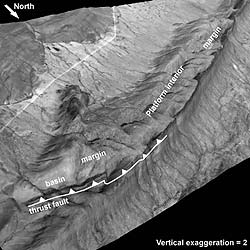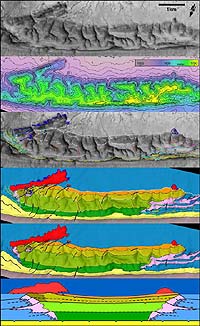 An isolated
terminal Proterozoic (ca. 550 Ma) carbonate platform
developed downdip on a carbonate ramp of the Nama Group, southern
Namibia. The isolated carbonate platform has two well-defined
margins that flank the platform interior. The platform was 10
km-wide, 500 m thick, and obtained syndepositional relief from
25 m to about 100 m. The stratigraphic evolution of the platform
was digitally reconstructed from an extensive dataset compiled
by using digital surveying technologies.
An isolated
terminal Proterozoic (ca. 550 Ma) carbonate platform
developed downdip on a carbonate ramp of the Nama Group, southern
Namibia. The isolated carbonate platform has two well-defined
margins that flank the platform interior. The platform was 10
km-wide, 500 m thick, and obtained syndepositional relief from
25 m to about 100 m. The stratigraphic evolution of the platform
was digitally reconstructed from an extensive dataset compiled
by using digital surveying technologies. The platform comprises three accommodation cycles in which each subsequent cycle experienced progressively greater influence of a long-term accommodation increase. Aggradation and progradation during the first cycle produced a flat, sheet-like platform. The coarsening and shallowing-upward sequence representing this first cycle is dominated by columnar stromatolitic thrombolites grading into massive and cross-bedded dolostones.
The second cycle features aggradation, formation of a distinct margin, and the development of a bucket geometry. The margin contained thrombolitic mounds and domes whereas the platform interior was dominated by columnar stromatolitic thrombolites. The final stage of platform development showed a deepening trend with initial aggradation and formation of well-bedded, thin deposits in the interior and mounds at the margins.
 While the
interior drowned, the platform margin kept up with rising sea
level and a complex pinnacle reef formed, which contained fused
and coalesced thrombolite mounds flanked by bioclastic grainstones
and collapse breccias. A set of isolated large thrombolitic mounds
flanked by shales indicate the final stage of the carbonate
platform before drowning.
While the
interior drowned, the platform margin kept up with rising sea
level and a complex pinnacle reef formed, which contained fused
and coalesced thrombolite mounds flanked by bioclastic grainstones
and collapse breccias. A set of isolated large thrombolitic mounds
flanked by shales indicate the final stage of the carbonate
platform before drowning. The overall geometric evolution of the platform from flat-topped to bucket with elevated margins is recorded in many Proterozoic and Phanerozoic isolated carbonate platforms. This study clearly illustrates that accommodation changes were fundamentally important to development of microbial-dominated carbonate platforms before the dawn of metazoan-dominated platforms.

